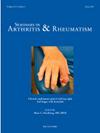快速获取策略对疑似风湿性多肌痛患者转诊率、诊断和糖皮质激素启动的影响
IF 4.4
2区 医学
Q1 RHEUMATOLOGY
引用次数: 0
摘要
目的风湿病多肌痛(PMR)诊断困难,50%的患者在风湿病评估前就开始使用糖皮质激素(GC),这对其与其他疾病的区别提出了挑战。针对疑似PMR患者的快速获取策略(RAS)诊所可能会在风湿病学评估前减少GC的发生,但证据有限。本研究评估了RAS诊所与传统转诊方法对疑似PMR患者的影响。方法该单中心回顾性队列研究比较了RAS诊所的疑似PMR患者与历史队列患者。比较包括转诊率、从转诊到评估的时间、诊断和评估前的GC启动。结果RAS诊所实施后,转诊率几乎翻了一番,评估时诊断为PMR的比例略有变化(70% [95% CI: 62-77]对59% [95% CI: 52-65])。与历史队列相比,RAS队列中更多的个体在一周内(55% [95% CI: 49-62]对36% [95% CI: 28-44])和两周(89% [95% CI: 84-92]对75% [95% CI: 67-81])接受评估。此外,在评估前进行GCs的患者较少(9% [95% CI: 6-13]对20% [95% CI: 15-28]),在诊断一年后接受GCs的患者较少(50% [95% CI: 39-61]对77% [95% CI: 62-89])。亚临床巨细胞动脉炎的比例仍然很低。结论对疑似PMR患者实施RAS门诊增加了转诊率,同时适度降低了诊断为PMR的比例,并降低了评估前启动GCs的比例。本文章由计算机程序翻译,如有差异,请以英文原文为准。
Impact of a rapid access strategy on referral rates, diagnosis, and glucocorticoid initiation in suspected polymyalgia rheumatica
Objectives
Diagnosing polymyalgia rheumatica (PMR) is difficult, and 50 % have initiated glucocorticoids (GC) before rheumatological evaluation, challenging the distinction from other conditions. Rapid access strategy (RAS) clinics for individuals with suspected PMR may reduce GC initiation before rheumatological evaluation, but evidence is limited. This study evaluates the impact of a RAS clinic compared with a traditional referral approach for individuals with suspected PMR.
Methods
This single-centre retrospective cohort study compared individuals suspected of PMR referred to a RAS clinic with a historical cohort. Comparisons included referral rates, time from referral to evaluation, diagnosis, and GC initiation before evaluation.
Results
Referral rates almost doubled after the RAS clinic was implemented with modest change in the proportion diagnosed with PMR at evaluation (70 % [95 % CI: 62–77] vs. 59 % [95 % CI: 52–65]). Compared with the historical cohort, more individuals in the RAS cohort were evaluated within one week (55 % [95 % CI: 49–62] vs. 36 % [95 % CI: 28–44]) and two weeks (89 % [95 % CI: 84–92] vs. 75 % [95 % CI: 67–81]). Additionally, fewer individuals initiated GCs before evaluation (9 % [95 % CI: 6–13] vs. 20 % [95 % CI: 15–28]) and fewer patients received GCs one year after diagnosis (50 % [95 % CI: 39–61] vs. 77 % [95 % CI: 62–89]). The proportion with subclinical giant cell arteritis remained low.
Conclusion
Implementation of a RAS clinic for individuals with suspected PMR increased referral rates, while modestly reducing the proportion diagnosed with PMR, and lowered the proportion of individuals initiating GCs before evaluation.
求助全文
通过发布文献求助,成功后即可免费获取论文全文。
去求助
来源期刊
CiteScore
9.20
自引率
4.00%
发文量
176
审稿时长
46 days
期刊介绍:
Seminars in Arthritis and Rheumatism provides access to the highest-quality clinical, therapeutic and translational research about arthritis, rheumatology and musculoskeletal disorders that affect the joints and connective tissue. Each bimonthly issue includes articles giving you the latest diagnostic criteria, consensus statements, systematic reviews and meta-analyses as well as clinical and translational research studies. Read this journal for the latest groundbreaking research and to gain insights from scientists and clinicians on the management and treatment of musculoskeletal and autoimmune rheumatologic diseases. The journal is of interest to rheumatologists, orthopedic surgeons, internal medicine physicians, immunologists and specialists in bone and mineral metabolism.

 求助内容:
求助内容: 应助结果提醒方式:
应助结果提醒方式:


